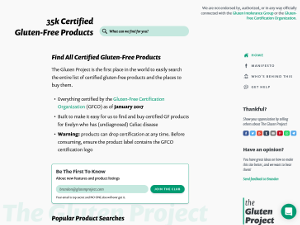Gluten-free eating is becoming more popular as more and more people have developed sensitivities and intolerances to wheat. As someone diagnosed with celiac disease, I know the struggles of gluten-free eating on a daily basis. Shopping for food is a stressful experience when packages aren’t specifically labeled, and many people can’t take chances with what they eat.
Luckily, some tools have been created to help discern what’s what. A new search engine called The Gluten Project is aimed at helping folks with gluten intolerances determine whether or not that box of soup or turkey jerky they buy at the store contains traces of gluten.
According to an article on website CNET, The Gluten Project catalogs 35,000 products that have been certified as gluten-free by the Gluten-Free Certification Organization. It’s simple to navigate – just type in a food into the search box and see if it appears in the results. You can click on links to gather more information about the product, but if you don’t find your food listed, chances are it does contain gluten.
While the site is an affiliate of Thrive Market, Nuts.com, and Walmart, the majority of products on the site don’t link to purchasing; it’s up to you to find them at your local grocery stores. (A few however, do link to Amazon where you can purchase directly online.)
The Gluten Project was started by a young couple in Dayton, Ohio, who were trying to eat gluten-free and having a hard time figuring out what to eat based on standard food labels.
More products are being labeled gluten-free, but for those with sensitivities, guessing what does and doesn’t contain gluten when it’s not specifically labeled can cause serious reaction. While foods sold in stores are required to list their ingredients, too often gluten can be added as a filler without being specifically listed as such. For instance, traces of gluten can be added under vague descriptions like “spices.” This is why a gluten-free label is important.
There is also the added challenge (for those with diseases such as celiac) of cross-contamination. Sometimes, food which doesn’t contain gluten as an ingredient, but is processed in a facility that also packages foods made with gluten, can put people at risk.
CNET also sites another gluten-identifying app for when you are shopping at the store and don’t want to tap out search queries via The Gluten Project. There’s Gluten Free Scanner, a free app that allows you to scan a barcode and immediately find out if it contains gluten. The app has a database of more than 500,000 products.
Either way, it’s becoming easier than ever to identify and avoid products that contain gluten, a welcome relief to those with intolerances.













